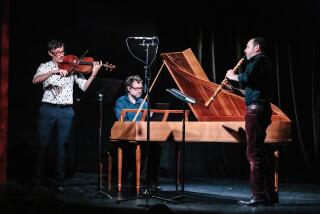Playing With Fire
The Emerson String Quartet seems to be two quartets, depending on which of the violinists--Philip Setzer or Eugene Drucker--plays in the first-chair position. That was the impression the group left in 1996 when it played the Irvine Barclay Theatre, and when the Emersons returned to the Barclay on Monday to play music of Beethoven and Shostakovich, they created the same impression--only in reverse.
Maybe it’s a matter of theater acoustics affecting who is sitting forward on the stage. Or maybe it’s early senility on the part of the critic.
Whatever the cause, with Setzer playing first violin, Beethoven’s Quartet in G, Opus 18, No. 2 sounded warm and mellow, a decided throwback to a polite and polished pre-Beethoven period.
This was odd because in 1996 Setzer seemed the firebrand. But he and his colleagues--violist Lawrence Dutton and cellist David Finckel round out the ensemble--sounded rather bland and faceless in this music.
Surely we should hear some hints, even in this relatively gentle work, of the tremendous struggle and despair the 27-year-old composer was feeling during the writing of Opus 18, as his hearing began to seriously deteriorate and force him into isolation.
There were no such hints, however, in the playing. There was little tension and little individuality--either of the composer or of the musicians.
But when Drucker--who had seemed a bit pale a few years ago--took over at first violin in Shostakovich’s Quartet No. 1 and Beethoven’s First “Rasoumovsky” Quartet (Opus 59, No. 1), emotional values heated up considerably.
Admittedly, these two works emerged from entirely different worlds than did the earlier Beethoven piece.
Shostakovich was reeling in 1936 from bitter criticism in the Communist Party paper Pravda of his opera “Lady Macbeth of Mtsensk” and was seeking to calm official reaction with his Fifth Symphony (a year later) and his first quartet (a year after that).
The composer referred to the quartet innocuously as “a ‘springtime’ work” without any great depth, although, as usual, Shostakovich’s music is anything but simple, and any statement he made about it should not be taken at face value.
Rather, an autumnal sense of wistfulness and recollection is evident in the quartet, as least as played here, and the resurgence of life energy in the final movement is a statement of faith and connection to nourishing Russian roots that have nothing to do with political parties.
*
For his part, Beethoven was at the height of his considerable heroic powers when writing Opus 59. He had little regard for the immense difficulties his music caused the players. His invention, intricacy and range here, not surprisingly, reached astonishing heights.
In both these works, all four musicians came alive in a new way. They played with a tension, electricity and drive missing earlier. The ensemble was tight and vital. Each mirrored the others’ phrasing and dynamics alertly and responsively. The musicians even allowed, where it fit into the music, a sense of playfulness.
It was exciting and nourishing.
With Setzer back in the first chair, the group played the Third Movement of Webern’s Opus 5 as the single encore. The fire was still evident.
More to Read
The biggest entertainment stories
Get our big stories about Hollywood, film, television, music, arts, culture and more right in your inbox as soon as they publish.
You may occasionally receive promotional content from the Los Angeles Times.










